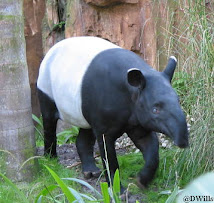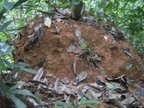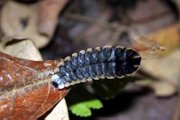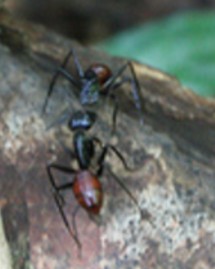
Pic by Cyril Ritter
WILDLIFE:
The tropical rainforest of Malaysia holds one of the richest faunas in the world. However, due to the density of the vegetation and the animals secretive habits, wildlife is difficult to see. To increase your chance of wildlife sightings, observe the following;
• Be quiet
• Dress as inconspicuous as possible
• Be like the wildlife, up at dawn, rest in the middle of the day, and active again at dusk.
• Along the trails, stop for a few minutes at a time. Be constantly alert for sounds and movement.
The lowland dipterocarp forest, which constitute about 57 % of the park area, is reach and diverse in faunal community. The abundant food plants, variety of habitat types and major drainage systems provide all the necessary survival requirements for wildlife. Elephant, tiger, leopard, other cats, Sumatran rhinoceros, honey bear, wild dog, serrow (mountain goat), porcupine, scaly anteater - all are present here and all have been observed in the wild. However, sightings are rare indeed. Elephant tracks and dropping and tiger tracks are fairly common around here.
Elephant ( Elephas maximus ) herds are distributed mostly in Ulu Atok, Ulu Keniam, Chamir, Ulu Aring, Kuala Koh, Sungai Trenggan, Sungai Kerbat, Jenut Kumbang, Jenut Reking and the adjacent Lake Kenyir. It is also reported that a few heads are found in Kenong Rimba Park in Kenong Valley. The elephant population is estimated to be about 400 animals.
Description of what you may see while in the forest;
Tapir ( Tapirus indicus ) - Black with a white 'saddle' and ear tips. Three toes on the hind foot and four on the forefoot.
Sambar Deer ( Cervus unicolor ) - The largest deer. Herd of 5-10, including stags, sometimes graze on secondary clearings. Individual ( Solitary) animals. Often seen after dark.
Barking Deer ( Muntiacus muntjak ) - About goat size, rich orange-brown with white under the tail.
Wild Pig ( Sus scrofa ) - Grey with heavy forequarters. A drove of up to 20 sows and may also seen along the trail
Long Tailed Macaque ( Macaca fecicularis ) - Also seen in the forest but most frequent sightings nearby the river. Rarely solitary-usually in troops of eight or more monkeys from young ones to adults.
White Handed Gibbon ( Hylobates lar ) - Rarely seen but common with their source of loud 'wak-wak' and high wailing calls heard from the tree-top early in the mornings. A color varies from black to cream, always with a pale ring around the face and pale hands and feet and no tail.
Dusky Leaf Monkey (Presbytis melalophos) - Dark gray with conspicuous rings of white flesh around the eyes and mouth. Long-tailed. Common around based camp.
Butterflies - Are present in greatest abundance between April and September. Brightly colored clusters make fine displays along river margins, and individuals are often encountered along the trails.
Snakes - Tree snakes - slender, often brightly marked and non-venomous -are occasionally seen draped across low branches beside trails. Poisonous snakes are rarely seen and all snakes will retreat at human approach.
Leech - Relative of the worm. Feeds on animals including human blood. Does not leave its teeth inside when removed from its victim. Does not cause primary infections. Treating your footwear with insect repellent is usually sufficient to keep the leeches away.

Squirel - By Cyril Ritter

Varan - By Cyril Ritter





